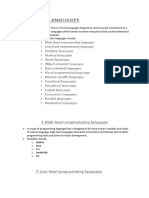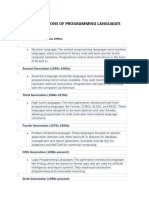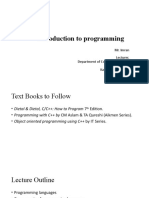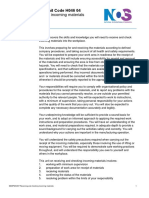0% found this document useful (0 votes)
4 views3 pagesComputer Science Languages
Computer science languages, or programming languages, are formal systems that enable humans to instruct computers. They are categorized by level of abstraction (low-level vs. high-level), programming paradigm (procedural, object-oriented, functional, scripting, logic-based), and execution model (compiled, interpreted, hybrid). Major programming languages include C, Java, Python, and JavaScript, each serving specific applications in areas like web development, data science, and systems programming.
Uploaded by
sahebiobaidullahCopyright
© © All Rights Reserved
We take content rights seriously. If you suspect this is your content, claim it here.
Available Formats
Download as DOCX, PDF, TXT or read online on Scribd
0% found this document useful (0 votes)
4 views3 pagesComputer Science Languages
Computer science languages, or programming languages, are formal systems that enable humans to instruct computers. They are categorized by level of abstraction (low-level vs. high-level), programming paradigm (procedural, object-oriented, functional, scripting, logic-based), and execution model (compiled, interpreted, hybrid). Major programming languages include C, Java, Python, and JavaScript, each serving specific applications in areas like web development, data science, and systems programming.
Uploaded by
sahebiobaidullahCopyright
© © All Rights Reserved
We take content rights seriously. If you suspect this is your content, claim it here.
Available Formats
Download as DOCX, PDF, TXT or read online on Scribd
/ 3





















































































